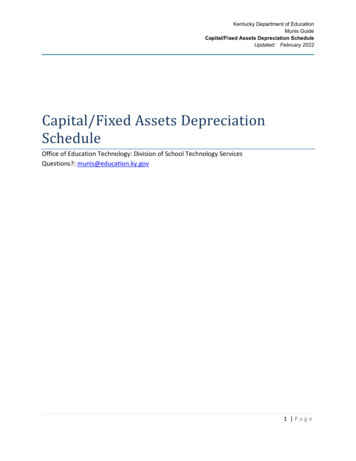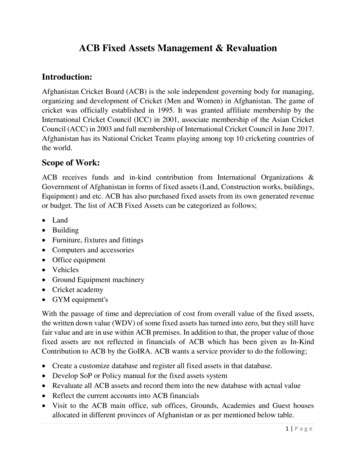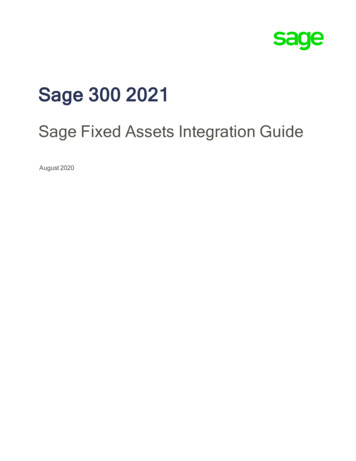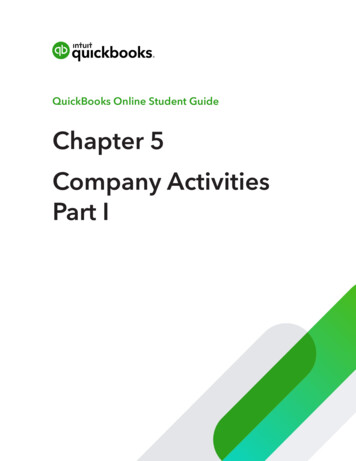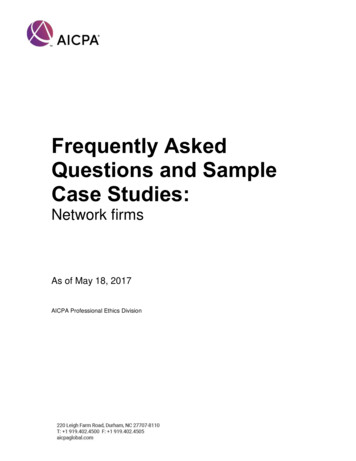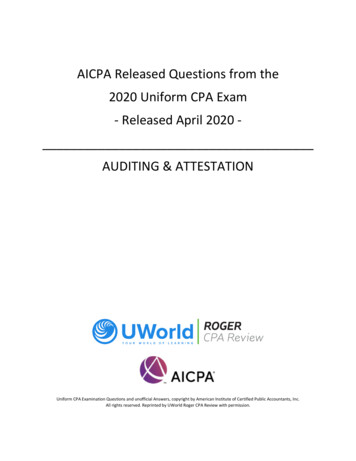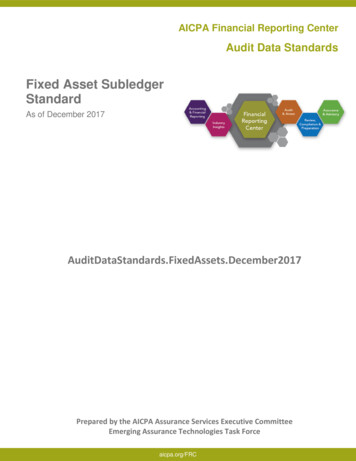
Transcription
AICPA Financial Reporting CenterAudit Data StandardsFixed Asset SubledgerStandardAs of December pared by the AICPA Assurance Services Executive CommitteeEmerging Assurance Technologies Task Forceaicpa.org/FRC
Copyright 2017by American Institute of Certified Public Accountants, Inc.New York, NY 10036-8775Permission is granted to make copies of this work provided that such copies are for personal, intraorganizational, oreducational use only and are not sold or disseminated and provided further that each copy bears the following credit line:“Copyright 2017 by American Institute of Certified Public Accountants, Inc. Used with permission.”aicpa.org/FRC
Assurance Services Executive Committee (2016 – 2017)Robert Dohrer, ChairBradley AmesChristine M. AndersonBradley BeasleyNancy BumgarnerJim BurtonChris HaltermanMaryGrace DavenportJennifer HaskellBrad MunizMichael PtasienskiJoanna PurtellMiklos VasarhelyiEmerging Assurance Technologies Task ForceAudit Data Standard & Audit Data Analytics Working GroupWilliam R. Titera, ChairJoel Pinkus, LeadPaul BarbourKarl BuschCheryl CaldwellEric E. CohenBrian CollinsHunter CookPaul DemastusRobert DohrerKristine HasenstabDale LivezeyMark MayberryJosh PhillipsDaniel ShorsteinMiklos VasarhelyiAdditional ContributorsNicola Dalla ViaAICPA StaffAmy PawlickiVice PresidentAssurance & Advisory InnovationAmi BeersDirectorAssurance and Advisory Services, CorporateReportingDorothy McQuilkenSenior ManagerAudit Data Analytics and ERMaicpa.org/FRC
Audit Data StandardsThe benefits of standardization are well recognized and have led to the development of various general IT standards.One reason data standards are needed is to address the ongoing challenge that management as well as internal andexternal auditors face in the efficient exchange of a company’s1 data. This process is complicated by the fact thataccounting and IT personnel approach requests for such information from different perspectives. For example, in somecases, audit-related data requests are forwarded directly to a company’s IT department, with limited furtherinvolvement from the accounting or finance department. In many cases, the burden is on the auditors to acquire thedata.The AICPA Assurance Services Executive Committee believes that audit data standards (ADS) will contribute to theefficiency and effectiveness of the audit process through standardization of the format for fields and files commonlyrequested for audit and other related purposes. Similarly, other consumers of the standardized information (such ascreditors) would also benefit if a company chose to share that data with them. Both large and small, as well as publicand private, companies also stand to benefit from the application of the ADS. By standardizing the data requested byauditors on a regular basis, companies will be able to automate and replicate the information request process, therebyreducing the amount of time and effort required to provide the requested data. Company staff and internal audit willalso benefit from enhanced analytical capabilities by leveraging the standardized data for internal purposes. Thestandard will also make the data usable for external auditors to perform enhanced data analysis.These standards represent leading practices that well-designed accounting and financial reporting systems are capableof adhering to. This publication addresses the Fixed Asset Subledger Audit Data Standard.ADS address both the technical design (files, tables, fields, formats, and so on) and supplemental questions about thedata that are essential for an understanding of its use. The former generally is best addressed through IT systemsdesign and the latter is commonly provided by accounting or finance personnel, with input from IT personnel. Pleasenote that these are voluntary, recommended data standards for the extraction of information. These data extractstandards are not required, nor do they represent authoritative audit or accounting standards.Recognizing the value of uniformity and the benefits of individual adaptation, particularly for companies of varying sizesand industry characteristics, these standards provide some degree of flexibility. These standards are sensitive tospecific requirements in different countries and have international applicability. This is a minimum standard and is notmeant to be limiting; therefore, users may create customized, user-defined fields (for example, items should not besubtracted, but they may be added where they do not already exist in the standard). However, to achieve the benefitsof standardization (when not specifically indicated), individual customization should be avoided. (In other words, if anitem is defined in the standard, then do not redefine it). Once a company adopts a particular convention, the companyshould consistently export its data according to that convention, unless a major IT system conversion is undertaken orthe producers and consumers of the standardized data mutually agree on an expansion, or both.1Please note that the term company is meant to represent companies, partnerships, government agencies, notfor-profit entities, and so on, and is not limited to commercial entities.aicpa.org/FRC
The audit data standards specifications were designed based on the needs of the majority of systems encountered bytheir designers. For the flat file (pipe-delimited) format, this means that certain “repetitive” fields were fixed at acertain number. These include the following: Business Unit Listing in Base Standard:- Business Unit Hierarchy[1] – [5] GL Detail YYYYMMDD YYYYMMDD in General Ledger Standard et al:- Segment[01] – [05] Customer Master YYYYMMDD in Accounts Receivable Standard or Order-to-Cash Standard:- Addresses of Physical and Billing Invoices Received YYYYMDD YYYYMMDD in Procure-to-Pay Standard et al:- GL Debit Account Number and GL Credit Account NumberIn the last case, an entry line can have a set of debit and credit accounts. If produced in summary rather than in detail,the entire invoice can have only one set of debit and credit accounts unless1. the auditor and the client agree to append additional debit and credit accounts at the end of a line of detail andagree on the format or2. the XBRL GL format is used rather than using the pipe-delimited format. As noted in the XBRL GL column, XBRLGL uses a method to represent data that permits more entries than the flat file format.Where more complex, hierarchical, or repetitive entries are necessary, XBRL GL may be the more practical format forrepresenting the data shared using the audit data standards.Companies implementing the ADS should first contact their enterprise resource planning (ERP) or accounting packagevendor for assistance. If the vendor does not have a solution for adopting the ADS, then extract, transform, load (ETL)vendors have developed scripts that can be used to map to the ADS.Prior to implementing these data standards, an evaluation should be made of the reliability of the data through the useof controls and segregation of duties testing. Guidance for these types of evaluation criteria is available atwww.aicpa.org.aicpa.org/FRC
1. Fixed Asset Subledger ADSThe Fixed Asset Subledger ADS is intended to accommodate basic analysis of the fixed asset process. The standard isintended to facilitate analysis performed as part of an audit, as well as analysis that might be performed by companystaff and internal audit in order to improve internal processes. Future updates to this standard may provide more detailand industry-specific content to broaden the opportunities for analysis.The Fixed Asset Subledger ADS is defined with multiple tables containing related information. Figure 2 provides a datadiagram that shows the relationship between tables in the Fixed Asset Subledger ADS. It is important to note that theFixed Asset Subledger ADS should be used in conjunction with the document Audit Data Standard—Base Standard,which is located on the AICPA’s website.Figure 2: Data Relationships Among Tables in the Fixed Asset Subledger Audit Data StandardThe “level” column for data fields within each table of the Fixed Asset Subledger ADS has a label ofeither “1” or “2” to indicate the importance of the data. Level 1 items are required (when availablethrough IT systems or additional means). The level 2 items are recommended, but may not always beavailable. The fields that are not available should be specified. It is important to note that the FixedAsset Subledger Standard should be used in conjunction with the Audit Data Standard – Base Standarddocument, which is located on the AICPA’s website.aicpa.org/FRC
The following subsections detail the Fixed Asset Subledger ADS:2.0 Fixed Asset Standardized Data22.12.22.32.42Fixed Asset Master File YYYYMMDDFixed Asset Additions YYYYMMDD YYYYMMDDFixed Asset Removals YYYYMMDD YYYYMMDDFixed Asset Depreciation YYYYMMDD YYYYMMDDPlease note that for table names with two dates, the dates represent the extract criteria's beginning andending dates. For table names with one date, the date represents the "as of" date of the extract.aicpa.org/FRC
2.1 Fixed Asset Master File YYYYMMDDThe Fixed Asset Master File YYYYMMDD table contains location information and product information used to identify the fixed assets ininventory.Field #Field NameLevel1Business Unit Code1Flat File DataData TypeLengthTEXT252Location ID1TEXT753Location Code1TEXT254Location Description2TEXT1005Fixed Asset ID1TEXT100aicpa.org/FRCXBRL GL tSubTypeof “Business Unit”For XBRL GL, A locationthat is forced to beunique isn’t a singlefield; concatentate theBusiness Unit Codeand Location Codes’sXBRL GL concepts to tieback (need to considerinterrelationships withother glbus:organizationAddressDescriptionFor XBRL GL,Fixed Asset Code isn’tforced to be unique;CommentUsed to identify thebusiness unit, region,branch, and so on at thelevel that financialstatements are beingaudited. Must match aBusiness Unit Code intheBusiness Unit Listingfile.Unique identifier fororganizations. Mayrequire a concatenationof items such asBusiness Unit Code andLocation Code.Code used to identifyfixed asset location atlocal, rather thanorganizational, level.Textual description oflocation identified byLocation Code.Unique identifier; mayrequire a concatenation,such as
Field #Field NameLevelFlat File DataData TypeLength6Fixed Asset Code1TEXT257Fixed Asset Description1TEXT1008Fixed Asset Bar Code2TEXT259Serial Number2BOOLEAN5aicpa.org/FRCXBRL GL TaxonomyElementconcatentate theBusiness Unit CodeandFixed Asset Code’sXBRL GL concepts to tieback (need to considerinterrelationships withother files)gl-bus:measurableIDwhere glbus:measurableCode eIDOtherFor XBRL GL, SerialNumber and LotNumber are not twoseparate Booleanfields, but a selectionfrom an enumeratedvalue and an associatedfreeform field. Forserial only, select“serial” from glehm:serialLotCode(enumerated: serial,lot, other, neither)andleave glehm:serialLotDescription (freeform) blank. Forboth serial and lotCommentBusiness Unit Code Fixed Asset Code.An internal ID at thelocal level for trackingthis fixed asset.Description of fixedasset.UPC or other externalidentifier, such as theproduct code from aprimary vendor.Tracked by serialnumber. True or false.
Field #Field NameLevelFlat File DataData TypeLength10Lot Number2BOOLEAN511Manufacturer ID2TEXT10012Vendor ID2TEXT100aicpa.org/FRCXBRL GL TaxonomyElementtracked, use “other”from glehm:serialLotCode andenter SerialAndLot forglehm:serialLotDescriptionFor XBRL GL, SerialNumber and LotNumber are not twoseparate Booleanfields, but a selectionfrom an enumeratedvalue and an associatedfreeform field. For lotonly, select “lot” fromgl-ehm:serialLotCode(enumerated: serial,lot, other, neither)andleave glehm:serialLotDescription (freeform) blank. Forboth serial and lottracked, use “other”from glehm:serialLotCode andenter SerialAndLot cturergl-cor:identifierCodefor internal # with gl-CommentTracked by lot number.True or false.Manufacturer of fixedasset.Unique identifier for theprimary vendor of thefixed asset. Must match
Field #Field NameLevelFlat File DataData TypeLength13Fixed Asset Group 012TEXT2514Fixed Asset Group 022TEXT2515Fixed Asset Class1TEXT2516Fixed Asset Quantity OnHand1NUMERIC17Fixed Asset Original Cost1NUMERIC18Fixed Asset Replacement Cost2NUMERICaicpa.org/FRCXBRL GL TaxonomyElementcor:identifierType “vendor”glbus:measurableCategoryAdd as subcategory toglbus:measurableCategory using pipe ( )delimiter.glehm:measurableClassID (enumerated) toinclude codes from Invand PPE (for example,raw material, WIP,finished goods, land,building, F&, etc.), glehm:measurableClassDescription (freeform)glbus measurableQuantityUsing glbus:measurableCostPerUnit in a parallelmeasurable structurewith glbus:measurableQualifier “original cost”Using glbus:measurableCostPerUnit in a parallelmeasurable structurewith gl-Commenta Vendor ID in theVendors file.Fixed asset groupingdescriptor #1, e.g.project.Fixed asset groupingdescriptor #2.Class of fixed asset, e.g.Land, Buildings,Machinery, etc.Quantity of fixed assetitems on hand.Original cost of the fixedasset.Replacement cost of thefixed asset.
Field #Field NameLevelFlat File DataData TypeLength19Fixed Asset Fair Value2NUMERIC20Fixed Asset Depreciable Basis2NUMERIC21Fixed Asset Salvage Value2NUMERIC22Fixed Asset Net Book Value2NUMERIC23Fixed Asset AccumulatedDepreciation1NUMERICXBRL GL TaxonomyElementbus:measurableQualifier “replacement cost”Using glbus:measurableCostPerUnit in a parallelmeasurable structurewith glbus:measurableQualifier “fair value”Using glbus:measurableCostPerUnit in a parallelmeasurable structurewith glbus:measurableQualifier “depreciable basis”Using glbus:measurableCostPerUnit in a parallelmeasurable structurewith glbus:measurableQualifier “salvage value”gl-cor:amount(As this is the valuethat ties to books, it isthe primary amount.Other amounts areplaced in parallelmeasurable structures.)gl-bus:dmAmount24Fixed Asset Useful tFair value of the fixedasset.Depreciable basis of thefixed asset.Salvage value of thefixed asset.Net book value of thefixed asset.Accumulateddepreciation of the fixedasset.Total useful life of thefixed asset in months.
Field #Field NameLevel25Fixed Asset Useful LifeRemaining1Flat File DataData TypeLengthNUMERIC26Currency ID1TEXT27Fixed Asset Acquisition Date1DATE28Fixed Asset Inactive Flag2BOOLEAN29Fixed Asset In Service Date1DATE30Fixed Asset Retirement Date1DATE31Fixed Asset Disposal Date1DATE32Fixed Asset Available for Sale Date2DATE33Fixed Asset to be Abandoned or Disposed ofOther than by for Sale Date2DATE34Fixed Asset Asset Account2TEXTaicpa.org/FRC25XBRL GL TaxonomyElementRather than remaininglife in month, theending date fordepreciation isprovided with edDate100Associate with accountstructure (first) whereCommentRemaining useful life ofthe fixed asset inmonths.Identification of thecurrency used in thisreport.Date that fixed asset ispurchased or acquired.Flag indicating whetherthe fixed asset isinactive, (e.g. idle), orthat the fixed assetaccount is inactive, (i.e.no other activity shouldbe posted to theaccount).Date that fixed asset isplaced in service.Date that fixed asset istaken out of service.Date that fixed asset isdisposed.Date that fixed asset isavailable for sale.Date that fixed asset isabandoned, disposed of,or retired.GL account number onwhich Balance Sheet
Field #Field NameLevelFlat File DataData TypeLength35Fixed Asset CIP Account2TEXT36Fixed Asset CIP Flag2BOOLEAN37Fixed Asset DepreciationAccount2TEXTaicpa.org/FRC100100XBRL GL TaxonomyElementaccount content isstored in glcor:accountMainID andidentified as “asset”usingglcor:mainAccountTypeand glcor:mainAccountTypeDescription “Fixed Asset”Associate with accountstructure (second)where account contentis stored in glcor:accountMainID andidentified as “asset”usingglcor:mainAccountTypeand glcor:mainAccountTypeDescription “CIP”Indicate glcor:accountActive as“true” within thestructure withreference to theFixed Asset CIP AccountAssociate with accountstructure (third) whereaccount content isstored in glcor:accountMainID andidentified as nt is recognizedafter asset is placed inservice.GL account number onwhich Balance Sheetamount is recognizedbefore asset is placed inservice.Flag indicating whetherthe fixed asset isrecorded as CIP as of thereport date.GL account number onwhich IncomeStatement amount isrecognized fordepreciation.
Field #Field NameLevel38Fixed Asset AccumulatedDepreciation Account2Flat File DataData TypeLengthTEXT10039Fixed Asset UnrealizedGain Loss Account2TEXT10040Fixed Asset RealizedGain Loss Account2TEXT10041Segment012TEXT25aicpa.org/FRCXBRL GL TaxonomyElementAssociate with accountstructure (fourth)where account contentis stored in glcor:accountMainID andidentified as “liability”usingglcor:mainAccountTypeAssociate with accountstructure (fifth) whereaccount content isstored in glcor:accountMainID andidentified as “gain” or“loss” usingglcor:mainAccountTypeand and glcor:mainAccountTypeDescription “unrealized”Associate with accountstructure (sixth) whereaccount content isstored in glcor:accountMainID andidentified as “gain” or“loss” usingglcor:mainAccountTypeand and glcor:mainAccountTypeDescription “realized”XBRL GL trackshierarchy ID, hierarchydescription, andhierarchy type, so it cantrack code NA,CommentGL account number onwhich Balance Sheetamount is recognized foraccumulateddepreciation.GL account number onwhich Balance Sheetamount is recorded forunrealized gain/loss.GL account number onwhich IncomeStatement amount isrecognized for realizedgain/loss.Reserved segment fieldthat can be used forprofit center, division,fund, program, branch,project, and so on.
Field #42434445Field lat File DataData TypeLengthTEXTTEXTTEXTTEXT25252525XBRL GL TaxonomyElementdescription N. America,and type global areausing glcor:accountSubID,glcor:accountSubDescription, s andhierarchies arecaptured by glcor:parentSubAccountType (What is thehierarchy type this unitrolls up to?)See aboveSee aboveSee aboveSee aboveCommentSame as above.Same as above.Same as above.Same as above.Additional Comment for XBRL GLFor a Fixed Asset Master File, additional required or recommended fields include the following.ElementContentgl-cor:entriesTypevalue “master file”gl-cor:entriesCommentvalue “ads:Fixed Asset Master File YYYYMMDD”aicpa.org/FRCCommentExplicitly defines this as a master file, as perXBRL GL’s enumerations.[entriesComment] is the descriptive fielddescribing what is common in the collection ofinformation; introducing audit data standardnamespace and qualifier for type of collectionties it to this representation. An ads namespacewould be created with information associatedwith the date/versioning of this ADS.
2.2 Fixed Asset Additions YYYYMMDD YYYYMMDDThe Fixed Asset Additions YYYYMMDD YYYYMMDD table captures the basic attributes of fixed asset additions, including transfers in CIP.Field #17Field NameLevel1Business Unit Code1Flat File DataData TypeLengthTEXT252Fixed Asset Unique ID1TEXT3Addition Type14Fixed Asset ID5Fixed Asset Addition DateXBRL GL Taxonomy ElementCommentgl-cor:accountSubID withglcor:accountSubType of“Business Unit”Used to identify the businessunit, region, branch, and so onat the level that financialstatements are being audited.Must match aBusiness Unit Code in theBusiness Unit Listing gl-cor:documentTypeDescriptionwith gl-cor:documentType of otherunless a receipt or shipment, inwhich case gl-cor:documentType ofreceipt or shipmentFor XBRL GL, this isn’t a single field;use the Business Unit Code andFixed Asset Code’s XBRL GLconcepts to tie back (need toconsider interrelationships withother files)gl-cor:documentDateUnique identifier for theaddition entry.Description of the type of fixedasset addition (i.e. purchase,transfer, etc.).Must be valid entry inFixed Asset Master FileYYYYMMDD.Date that fixed asset ispurchased or acquired.
Field #Field NameLevel6Fixed Asset Cost1Flat File DataData TypeLengthNUMERIC7Placed In Service1BOOLEAN8Entered By1TEXT9Entered Date2DATEgl-cor:enteredDate10Entered Time2TIMEIncorporated into above field usingISO 860111Approved By2TEXT12Approved By Date2DATE13Approved By Time2TIME100100XBRL GL Taxonomy teRepeatIncorporated into above field usingISO 8601aicpa.org/FRCCommentOriginal cost of the acquiredfixed asset.True/false flag indicatingwhether the fixed asset wasplaced in service and begandepreciating on the additiondate.User ID (User Listing file) forperson who created the record.The date the transaction wasentered into the system. This issometimes referred to as thecreation date. This should be asystem-generated date (ratherthan user-entered date), whenpossible. This date does notnecessarily correspond with thedate of the transaction itself.The time this transaction wasentered into the system. ISO8601 representing time in 24hour time (hhmm) (for example,1:00 PM 1300).User ID (from User Listing file(for person who approved theentry).The date the entry wasapproved.The time this transaction wasentered into the system. ISO8601 representing time in 24hour time (hhmm) (for example,1:00 PM 1300).
Field #19Field NameLevel14Last Modified By2Flat File DataData TypeLengthTEXT100XBRL GL Taxonomy Element15Last Modified By Date2DATEgl-usk:lastDateRepeat16Last Modified By Time2TIMEIncorporated into above field usingISO 860117Serial Number2TEXT75gl-ehm:serialLotNumber is used foreither the serial or the lot number,and driven by the attributes ofserial or lot. If both are required,the lot number is placed in glehm:nextSerialLotNumber.18Lot Number2TEXT7519Acquisition Details2TEXT100gl-ehm:serialLotNumber is used foreither the serial or the lot number,and driven by the attributes ofserial or lot. If both are required,the lot number is placed in gment012TEXT25gl-bus:enteredByModifiedXBRL GL tracks hierarchy ID,hierarchy description, andhierarchy type, so it can track codeNA, description N. America, andtype global area using gl-CommentUser ID (from User Listing file(for person who approved theentry).The date the entry was lastmodified.The time the last entry wasmodified. ISO 8601 representingtime in 24-hour time (hhmm)(for example, 1:00 PM 1300).If serialized, the serial number iscaptured here. Although serialnumber is the common term,the value is not limited tonumeric values. While it isuncommon for an item to beboth serial and lot controlled(the serial numberunambiguously identifies theitem), the two are notnecessarily mutually exclusive.If representing a lot, the lotnumber is captured here.Although lot number is thecommon term, the value is notlimited to numeric values.This field could be the P.O.number, treasury documentnumber, or a plain textdescription.Reserved segment field that canbe used for profit center,division, fund, program, branch,project, and so on.
Field #21222324Field lat File DataData TypeLengthTEXTTEXTTEXTTEXT25252525XBRL GL Taxonomy n, andglcor:accountSubType, respectively.Interrelations and hierarchies arecaptured by glcor:parenSubAccountType.See aboveSee aboveSee aboveSee aboveCommentSame as above.Same as above.Same as above.Same as above.Additional Comment for XBRL GLFor a Fixed Asset Additions File, additional required or recommended fields include the following.ElementContentgl-cor:entriesTypevalue “other”gl-cor:entriesCommentvalue “ads:Fixed Asset Additions YYYYMMDD YYYYMMDD”aicpa.org/FRCCommentIndicates this is not one of the other of XBRL GL’sfixed list of enumerations.[entriesComment] is the descriptive fielddescribing what is common in the collection ofinformation; introducing audit data standardnamespace and qualifier for type of collectionties it to this representation. An ads namespacewould be created with information associatedwith the date/versioning of this ADS.
2.3 Fixed Asset Removals YYYYMMDD YYYYMMDDThe Fixed Asset Removals YYYYMMDD YYYYMMDD table captures all fixed asset removals, such as retirements, disposals, write-offs, andtransfers.Field#121Field NameLevelBusiness Unit Code1Flat File DataData TypeLengthTEXT50XBRL GL Taxonomy Element2Unique ID1TEXT25gl-cor:lineNumberCounter3Removal Type1TEXT254Fixed Asset ID1TEXT1005Fixed Asset Removal Date1DATEgl-cor:documentTypeDescription withgl-cor:documentType of other unless areceipt or shipment, in which case glcor:documentType of receipt orshipmentFor XBRL GL, this isn’t a single field; usethe Business Unit Code andFixed Asset Code’s XBRL GL conceptsto tie back (need to considerinterrelationships with other files)gl-cor:documentDate6Fixed Asset Removal CashProceeds Amount2NUMERICgl-cor:accountSubID withglcor:accountSubType of“Business Unit”Using gl-bus:measurableCostPerUnit ina parallel measurable structure with glbus:measurableQualifier “cash proceeds”CommentUsed to identify the businessunit, region, branch, and so onat the level that financialstatements are being audited.Must match aBusiness Unit Code in theBusiness Unit Listing file.Unique identifier for theremoval entry.Description of the type of fixedasset removal (i.e. retirement,disposal, transfer, write-off,etc.)Must be valid entry inFixed Asset Master FileYYYYMMDD.Date that fixed asset isremoved.Amount of cash proceedsreceived for the fixed assetremoval.
Field#7Field NameLevelFixed Asset Removal Non CashProceeds Amount2Flat File DataData TypeLengthNUMERIC8Fixed Asset Unrealized Gain LossAmount2NUMERIC9Fixed Asset Realized Gain LossAmount2NUMERIC10Fixed Asset UnrealizedGain Loss Account2TEXT10011Fixed Asset RealizedGain Loss Account2TEXT10012Entered by1TEXT10013Entered Date2DATEaicpa.org/FRCXBRL GL Taxonomy ElementUsing gl-bus:measurableCostPerUnit ina parallel measurable structure with glbus:measurableQualifier “noncash proceeds”Using gl-bus:measurableCostPerUnit ina parallel measurable structure with glbus:measurableQualifier “unrealized gain loss”Using gl-bus:measurableCostPerUnit ina parallel measurable structure with glbus:measurableQualifier “realized gain loss”Associate with account structure (first)where account content is stored in glcor:accountMainID and identified as“gain” or “loss” using glcor:mainAccountType and glcor:mainAccountTypeDescription “unrealized”Associate with account structure(second) where account content isstored in gl-cor:accountMainID andidentified as “gain” or “loss” usingglcor:mainAccountType and glcor:mainAccountTypeDescription mmentAmount of non-cash proceedsreceived for the fixed assetremoval.Amount of unrealizedgain/(loss) recorded on theBalance Sheet for the fixedasset removal.Amount of realized gain/(loss)recorded on the IncomeStatement for the fixed assetremoval.GL account number on whichBalance Sheet amount isrecorded for unrealizedgain/loss.GL account number on whichIncome Statement amount isrecognized for realizedgain/loss.User ID (User Listing file) forperson who created the record.The date the transaction wasentered into the system. This issometimes referred to as thecreation date. This should be asystem-generated date (ratherthan user-entered date), whenpossible. This date does not
Field#23Field NameLevelFlat File DataData TypeLengthXBRL GL Taxonomy Element14Entered Time2TIMEIncorporated into above field using ISO860115Approved By2TEXT16Approved By Date2DATE17Approved By Time2TIME18Last Modified By2TEXT19Last Modified By Date2DATEgl-usk:lastDateRepeat20Last Modified By Time2TIMEIncorporated into above field using ISO860121Serial extDateRepeatIncorporated into above field using otNumber is used foreither the serial or the lot number, anddriven by the attributes of serial or lot.If both are required, the lot number isplaced in gl-ehm:nextSerialLotNumber.Commentnecessarily correspond with thedate of the transaction itself.The time this transaction wasentered into the system. ISO8601 representing time in 24hour time (hhmm) (forexample, 1:00 PM 1300).User ID (from User Listing file(for person who approved theentry).The date the entry wasapproved.The time this transaction wasentered into the system. ISO8601 representing time in 24hour time (hhmm) (forexample, 1:00 PM 1300).User ID (from User Listing file(for person who approved theentry).The date the entry was lastmodified.The time the last entry wasmodified. ISO 8601representing time in 24-hourtime (hhmm) (for example,1:00 PM 1300).If serialized, the serial numberis captured here. Althoughserial number is the commonterm, the value is not limited tonumeric values. While it isuncommon for an item to beboth serial and lot controlled(the serial number
Field#Field NameLevelFlat File DataData TypeLength22Lot 525XBRL GL Taxonomy ElementCommentgl-ehm:serialLotNumber is used foreither the serial or the lot number, anddriven by the attributes of serial or lot.If both are required, the lot number isplaced in gl-ehm:nextSerialLot
The Fixed Asset Subledger ADS is defined with multiple tables containing related information. Figure 2 provides a data diagram that shows the relationship between tables in the Fixed Asset Subledger ADS. It is important to note that the Fixed Asset Subledger ADS should be used in conjunction with the document Audit Data Standard—Base Standard,
